CSR & Sustainability Report: Analysis of Medibank - BBAC502 Course
VerifiedAdded on 2023/05/30
|8
|2424
|58
Report
AI Summary
This report analyzes Medibank's Corporate Social Responsibility (CSR) disclosures, focusing on the company's limited reporting through annual reports and its website. The study identifies the stakeholder theory as the primary motivation for Medibank's CSR disclosures, considering the company's historical focus on stakeholder service rather than profit. The report examines the impact of Medibank's CSR reporting on the local community, highlighting increased awareness, participation, and support for community initiatives. It concludes that while Medibank's CSR reporting is not extensive, it positively influences the local community and is rooted in the company's historical commitment to stakeholders. Desklib provides a platform to access this and similar assignments for students' reference.
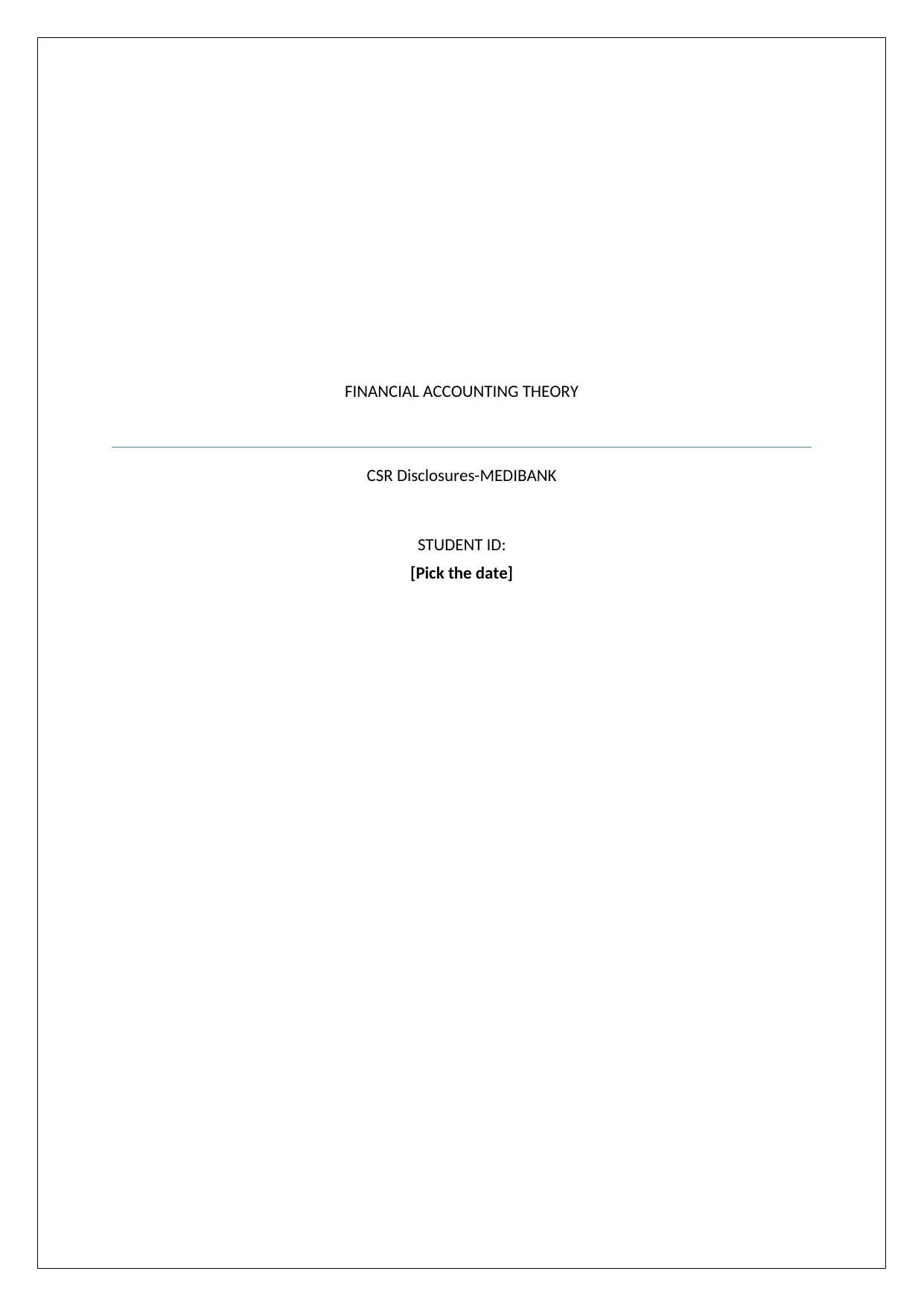
FINANCIAL ACCOUNTING THEORY
CSR Disclosures-MEDIBANK
STUDENT ID:
[Pick the date]
CSR Disclosures-MEDIBANK
STUDENT ID:
[Pick the date]
Paraphrase This Document
Need a fresh take? Get an instant paraphrase of this document with our AI Paraphraser
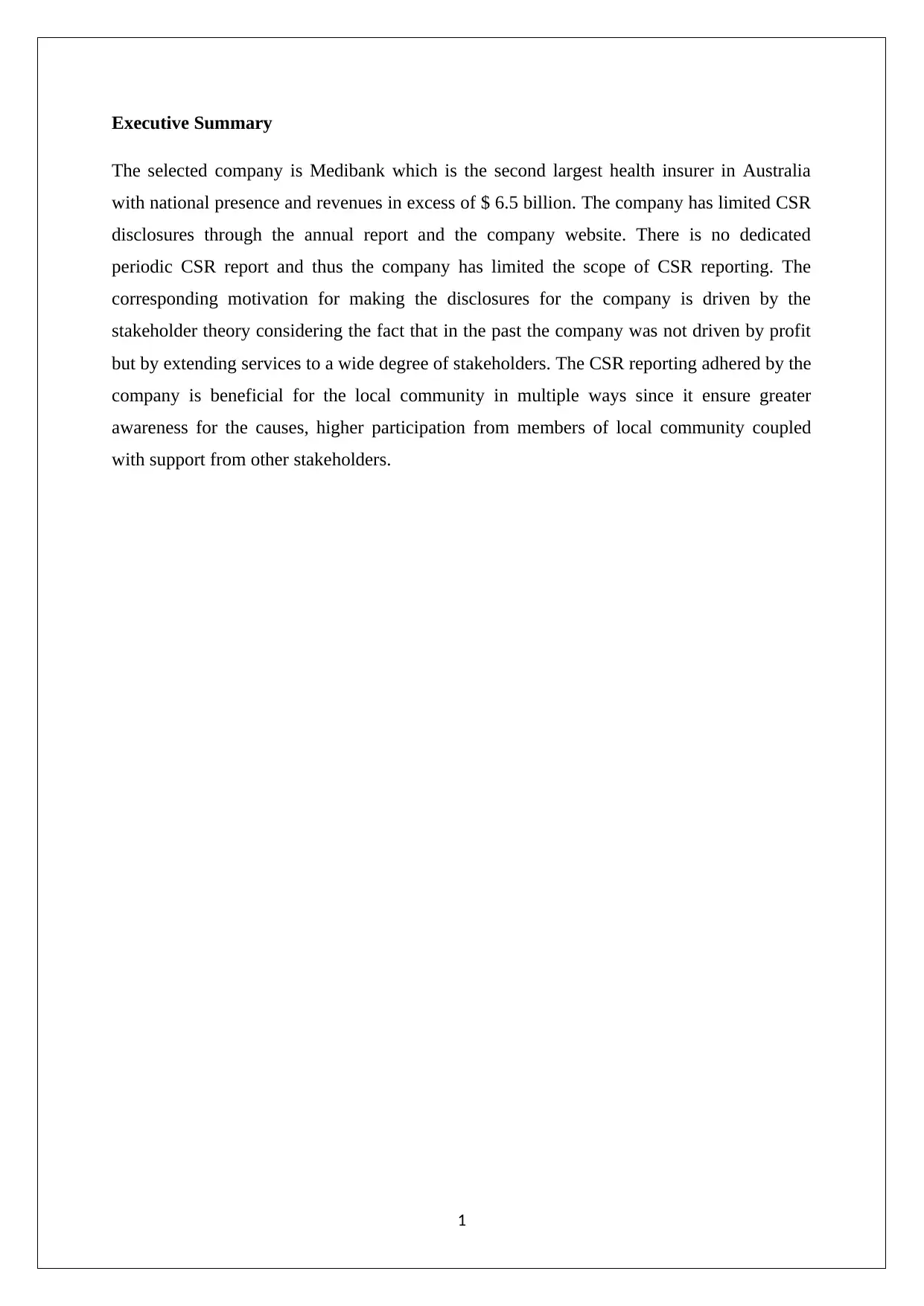
Executive Summary
The selected company is Medibank which is the second largest health insurer in Australia
with national presence and revenues in excess of $ 6.5 billion. The company has limited CSR
disclosures through the annual report and the company website. There is no dedicated
periodic CSR report and thus the company has limited the scope of CSR reporting. The
corresponding motivation for making the disclosures for the company is driven by the
stakeholder theory considering the fact that in the past the company was not driven by profit
but by extending services to a wide degree of stakeholders. The CSR reporting adhered by the
company is beneficial for the local community in multiple ways since it ensure greater
awareness for the causes, higher participation from members of local community coupled
with support from other stakeholders.
1
The selected company is Medibank which is the second largest health insurer in Australia
with national presence and revenues in excess of $ 6.5 billion. The company has limited CSR
disclosures through the annual report and the company website. There is no dedicated
periodic CSR report and thus the company has limited the scope of CSR reporting. The
corresponding motivation for making the disclosures for the company is driven by the
stakeholder theory considering the fact that in the past the company was not driven by profit
but by extending services to a wide degree of stakeholders. The CSR reporting adhered by the
company is beneficial for the local community in multiple ways since it ensure greater
awareness for the causes, higher participation from members of local community coupled
with support from other stakeholders.
1
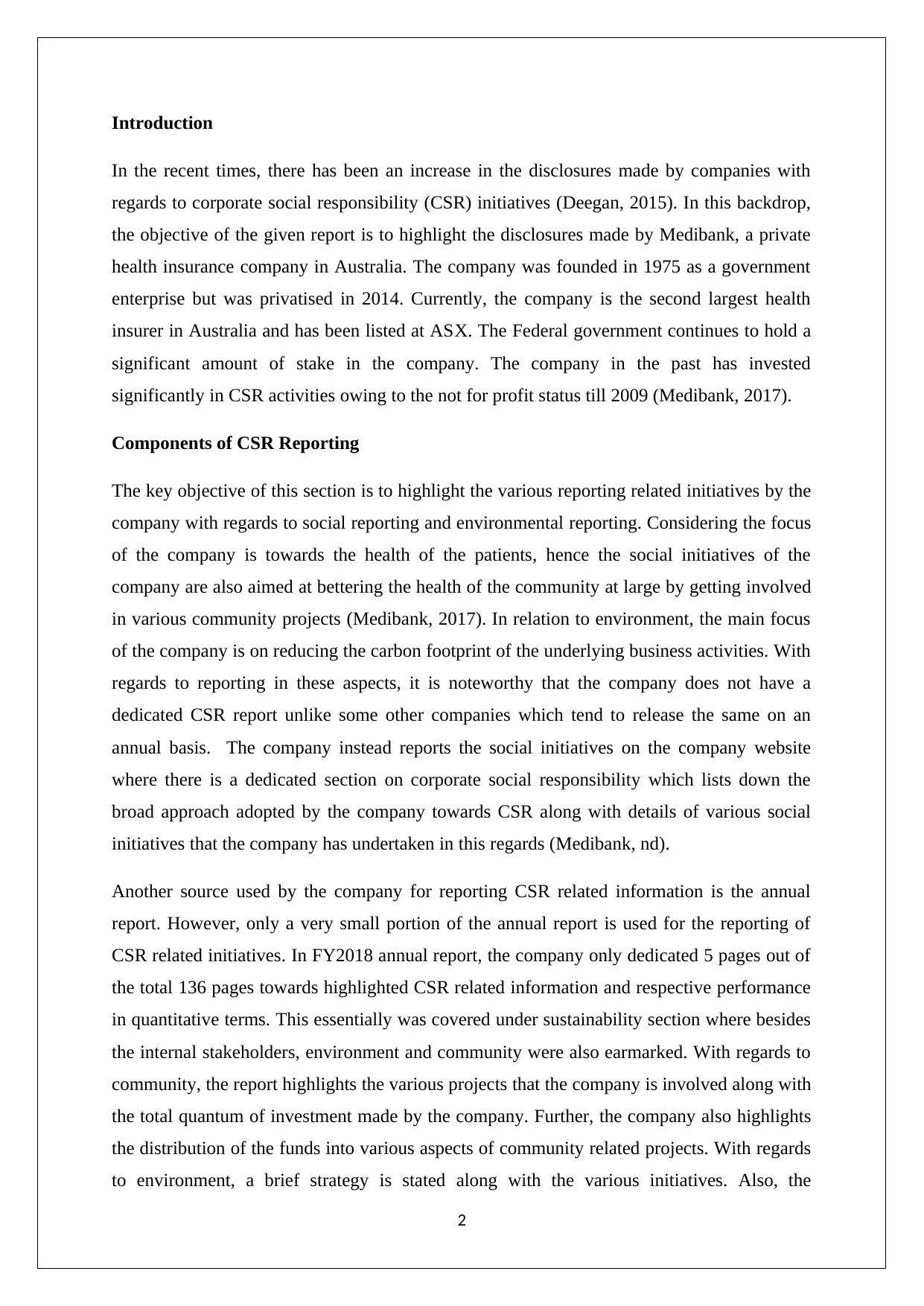
Introduction
In the recent times, there has been an increase in the disclosures made by companies with
regards to corporate social responsibility (CSR) initiatives (Deegan, 2015). In this backdrop,
the objective of the given report is to highlight the disclosures made by Medibank, a private
health insurance company in Australia. The company was founded in 1975 as a government
enterprise but was privatised in 2014. Currently, the company is the second largest health
insurer in Australia and has been listed at ASX. The Federal government continues to hold a
significant amount of stake in the company. The company in the past has invested
significantly in CSR activities owing to the not for profit status till 2009 (Medibank, 2017).
Components of CSR Reporting
The key objective of this section is to highlight the various reporting related initiatives by the
company with regards to social reporting and environmental reporting. Considering the focus
of the company is towards the health of the patients, hence the social initiatives of the
company are also aimed at bettering the health of the community at large by getting involved
in various community projects (Medibank, 2017). In relation to environment, the main focus
of the company is on reducing the carbon footprint of the underlying business activities. With
regards to reporting in these aspects, it is noteworthy that the company does not have a
dedicated CSR report unlike some other companies which tend to release the same on an
annual basis. The company instead reports the social initiatives on the company website
where there is a dedicated section on corporate social responsibility which lists down the
broad approach adopted by the company towards CSR along with details of various social
initiatives that the company has undertaken in this regards (Medibank, nd).
Another source used by the company for reporting CSR related information is the annual
report. However, only a very small portion of the annual report is used for the reporting of
CSR related initiatives. In FY2018 annual report, the company only dedicated 5 pages out of
the total 136 pages towards highlighted CSR related information and respective performance
in quantitative terms. This essentially was covered under sustainability section where besides
the internal stakeholders, environment and community were also earmarked. With regards to
community, the report highlights the various projects that the company is involved along with
the total quantum of investment made by the company. Further, the company also highlights
the distribution of the funds into various aspects of community related projects. With regards
to environment, a brief strategy is stated along with the various initiatives. Also, the
2
In the recent times, there has been an increase in the disclosures made by companies with
regards to corporate social responsibility (CSR) initiatives (Deegan, 2015). In this backdrop,
the objective of the given report is to highlight the disclosures made by Medibank, a private
health insurance company in Australia. The company was founded in 1975 as a government
enterprise but was privatised in 2014. Currently, the company is the second largest health
insurer in Australia and has been listed at ASX. The Federal government continues to hold a
significant amount of stake in the company. The company in the past has invested
significantly in CSR activities owing to the not for profit status till 2009 (Medibank, 2017).
Components of CSR Reporting
The key objective of this section is to highlight the various reporting related initiatives by the
company with regards to social reporting and environmental reporting. Considering the focus
of the company is towards the health of the patients, hence the social initiatives of the
company are also aimed at bettering the health of the community at large by getting involved
in various community projects (Medibank, 2017). In relation to environment, the main focus
of the company is on reducing the carbon footprint of the underlying business activities. With
regards to reporting in these aspects, it is noteworthy that the company does not have a
dedicated CSR report unlike some other companies which tend to release the same on an
annual basis. The company instead reports the social initiatives on the company website
where there is a dedicated section on corporate social responsibility which lists down the
broad approach adopted by the company towards CSR along with details of various social
initiatives that the company has undertaken in this regards (Medibank, nd).
Another source used by the company for reporting CSR related information is the annual
report. However, only a very small portion of the annual report is used for the reporting of
CSR related initiatives. In FY2018 annual report, the company only dedicated 5 pages out of
the total 136 pages towards highlighted CSR related information and respective performance
in quantitative terms. This essentially was covered under sustainability section where besides
the internal stakeholders, environment and community were also earmarked. With regards to
community, the report highlights the various projects that the company is involved along with
the total quantum of investment made by the company. Further, the company also highlights
the distribution of the funds into various aspects of community related projects. With regards
to environment, a brief strategy is stated along with the various initiatives. Also, the
2
⊘ This is a preview!⊘
Do you want full access?
Subscribe today to unlock all pages.

Trusted by 1+ million students worldwide
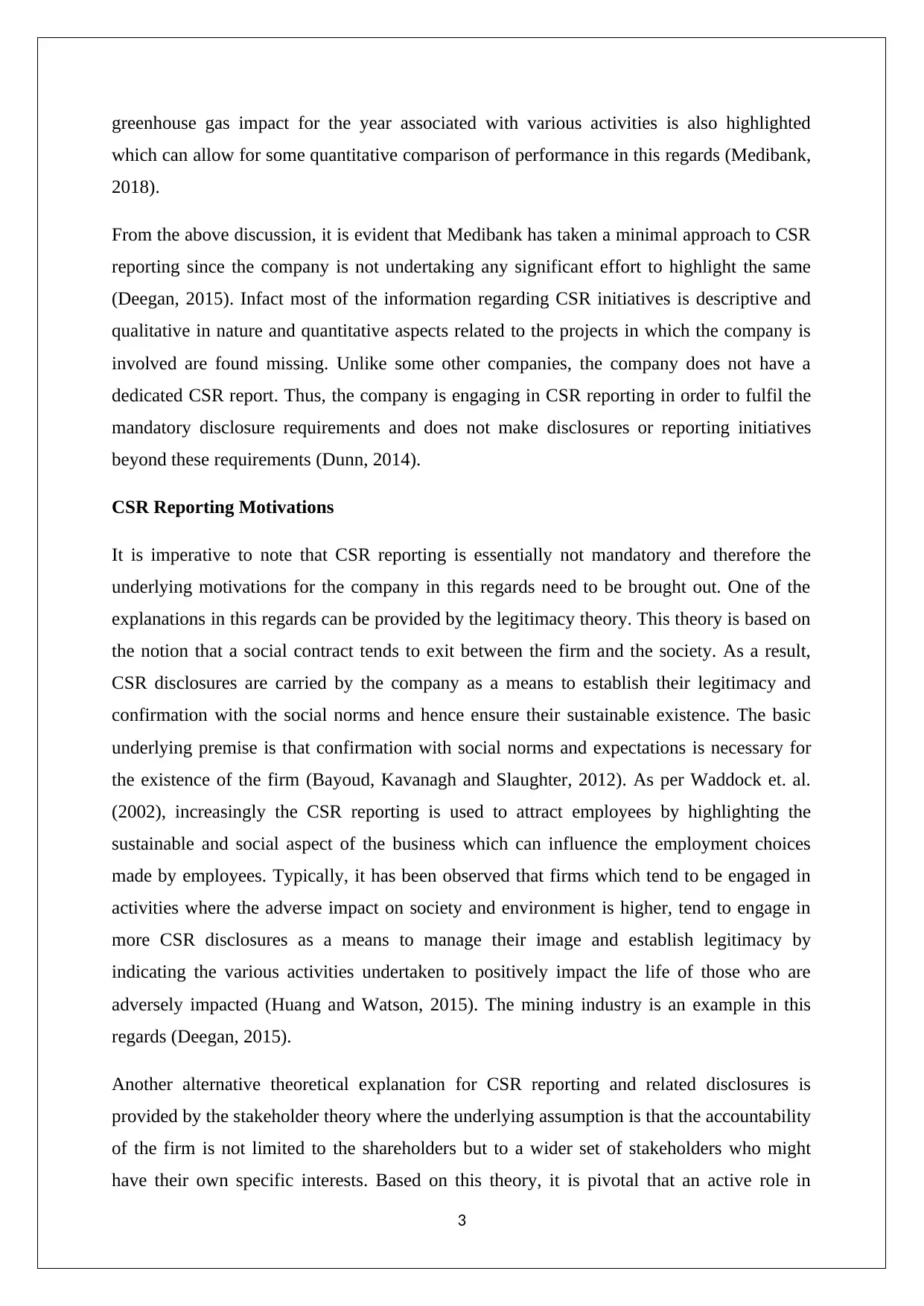
greenhouse gas impact for the year associated with various activities is also highlighted
which can allow for some quantitative comparison of performance in this regards (Medibank,
2018).
From the above discussion, it is evident that Medibank has taken a minimal approach to CSR
reporting since the company is not undertaking any significant effort to highlight the same
(Deegan, 2015). Infact most of the information regarding CSR initiatives is descriptive and
qualitative in nature and quantitative aspects related to the projects in which the company is
involved are found missing. Unlike some other companies, the company does not have a
dedicated CSR report. Thus, the company is engaging in CSR reporting in order to fulfil the
mandatory disclosure requirements and does not make disclosures or reporting initiatives
beyond these requirements (Dunn, 2014).
CSR Reporting Motivations
It is imperative to note that CSR reporting is essentially not mandatory and therefore the
underlying motivations for the company in this regards need to be brought out. One of the
explanations in this regards can be provided by the legitimacy theory. This theory is based on
the notion that a social contract tends to exit between the firm and the society. As a result,
CSR disclosures are carried by the company as a means to establish their legitimacy and
confirmation with the social norms and hence ensure their sustainable existence. The basic
underlying premise is that confirmation with social norms and expectations is necessary for
the existence of the firm (Bayoud, Kavanagh and Slaughter, 2012). As per Waddock et. al.
(2002), increasingly the CSR reporting is used to attract employees by highlighting the
sustainable and social aspect of the business which can influence the employment choices
made by employees. Typically, it has been observed that firms which tend to be engaged in
activities where the adverse impact on society and environment is higher, tend to engage in
more CSR disclosures as a means to manage their image and establish legitimacy by
indicating the various activities undertaken to positively impact the life of those who are
adversely impacted (Huang and Watson, 2015). The mining industry is an example in this
regards (Deegan, 2015).
Another alternative theoretical explanation for CSR reporting and related disclosures is
provided by the stakeholder theory where the underlying assumption is that the accountability
of the firm is not limited to the shareholders but to a wider set of stakeholders who might
have their own specific interests. Based on this theory, it is pivotal that an active role in
3
which can allow for some quantitative comparison of performance in this regards (Medibank,
2018).
From the above discussion, it is evident that Medibank has taken a minimal approach to CSR
reporting since the company is not undertaking any significant effort to highlight the same
(Deegan, 2015). Infact most of the information regarding CSR initiatives is descriptive and
qualitative in nature and quantitative aspects related to the projects in which the company is
involved are found missing. Unlike some other companies, the company does not have a
dedicated CSR report. Thus, the company is engaging in CSR reporting in order to fulfil the
mandatory disclosure requirements and does not make disclosures or reporting initiatives
beyond these requirements (Dunn, 2014).
CSR Reporting Motivations
It is imperative to note that CSR reporting is essentially not mandatory and therefore the
underlying motivations for the company in this regards need to be brought out. One of the
explanations in this regards can be provided by the legitimacy theory. This theory is based on
the notion that a social contract tends to exit between the firm and the society. As a result,
CSR disclosures are carried by the company as a means to establish their legitimacy and
confirmation with the social norms and hence ensure their sustainable existence. The basic
underlying premise is that confirmation with social norms and expectations is necessary for
the existence of the firm (Bayoud, Kavanagh and Slaughter, 2012). As per Waddock et. al.
(2002), increasingly the CSR reporting is used to attract employees by highlighting the
sustainable and social aspect of the business which can influence the employment choices
made by employees. Typically, it has been observed that firms which tend to be engaged in
activities where the adverse impact on society and environment is higher, tend to engage in
more CSR disclosures as a means to manage their image and establish legitimacy by
indicating the various activities undertaken to positively impact the life of those who are
adversely impacted (Huang and Watson, 2015). The mining industry is an example in this
regards (Deegan, 2015).
Another alternative theoretical explanation for CSR reporting and related disclosures is
provided by the stakeholder theory where the underlying assumption is that the accountability
of the firm is not limited to the shareholders but to a wider set of stakeholders who might
have their own specific interests. Based on this theory, it is pivotal that an active role in
3
Paraphrase This Document
Need a fresh take? Get an instant paraphrase of this document with our AI Paraphraser
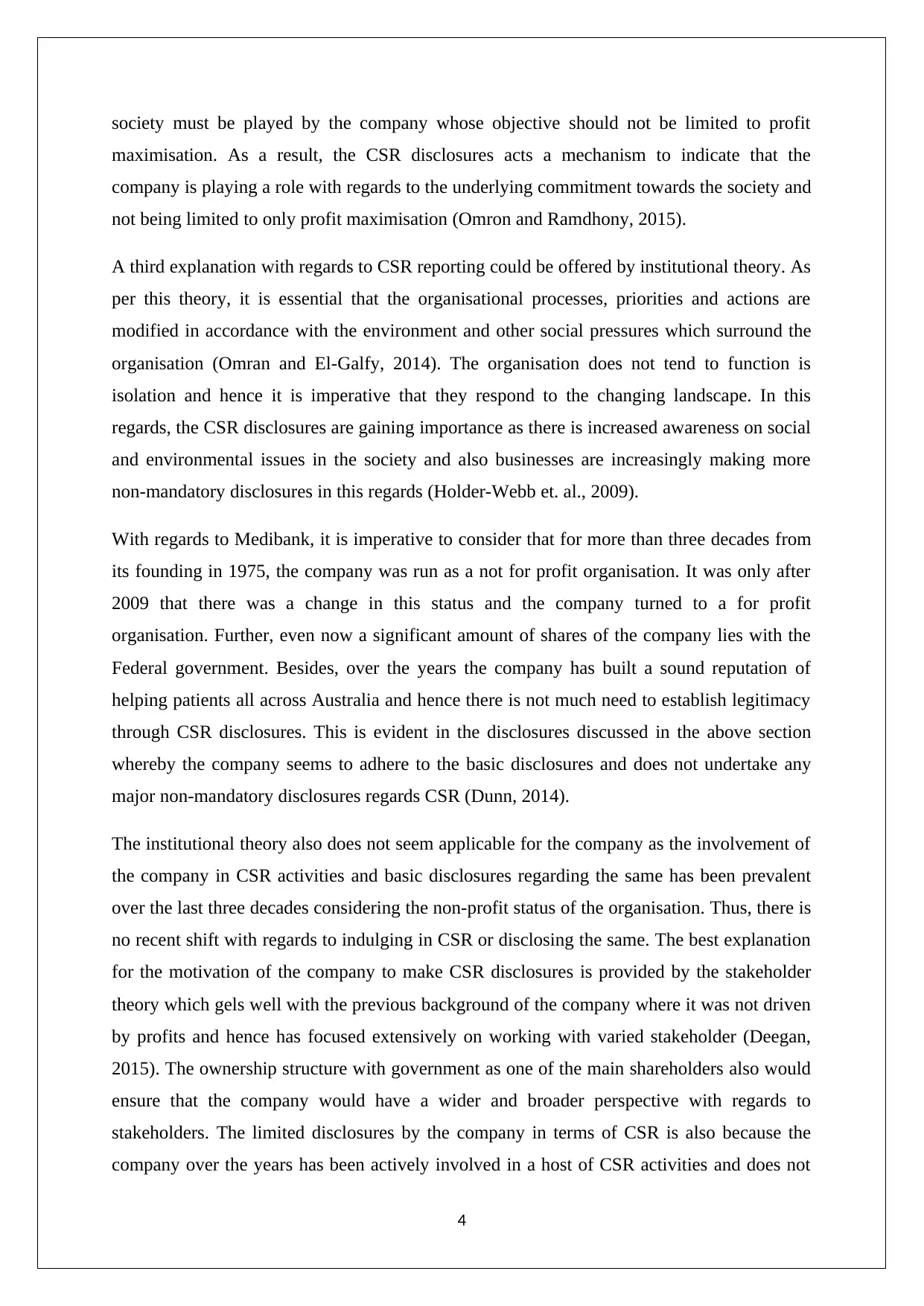
society must be played by the company whose objective should not be limited to profit
maximisation. As a result, the CSR disclosures acts a mechanism to indicate that the
company is playing a role with regards to the underlying commitment towards the society and
not being limited to only profit maximisation (Omron and Ramdhony, 2015).
A third explanation with regards to CSR reporting could be offered by institutional theory. As
per this theory, it is essential that the organisational processes, priorities and actions are
modified in accordance with the environment and other social pressures which surround the
organisation (Omran and El-Galfy, 2014). The organisation does not tend to function is
isolation and hence it is imperative that they respond to the changing landscape. In this
regards, the CSR disclosures are gaining importance as there is increased awareness on social
and environmental issues in the society and also businesses are increasingly making more
non-mandatory disclosures in this regards (Holder-Webb et. al., 2009).
With regards to Medibank, it is imperative to consider that for more than three decades from
its founding in 1975, the company was run as a not for profit organisation. It was only after
2009 that there was a change in this status and the company turned to a for profit
organisation. Further, even now a significant amount of shares of the company lies with the
Federal government. Besides, over the years the company has built a sound reputation of
helping patients all across Australia and hence there is not much need to establish legitimacy
through CSR disclosures. This is evident in the disclosures discussed in the above section
whereby the company seems to adhere to the basic disclosures and does not undertake any
major non-mandatory disclosures regards CSR (Dunn, 2014).
The institutional theory also does not seem applicable for the company as the involvement of
the company in CSR activities and basic disclosures regarding the same has been prevalent
over the last three decades considering the non-profit status of the organisation. Thus, there is
no recent shift with regards to indulging in CSR or disclosing the same. The best explanation
for the motivation of the company to make CSR disclosures is provided by the stakeholder
theory which gels well with the previous background of the company where it was not driven
by profits and hence has focused extensively on working with varied stakeholder (Deegan,
2015). The ownership structure with government as one of the main shareholders also would
ensure that the company would have a wider and broader perspective with regards to
stakeholders. The limited disclosures by the company in terms of CSR is also because the
company over the years has been actively involved in a host of CSR activities and does not
4
maximisation. As a result, the CSR disclosures acts a mechanism to indicate that the
company is playing a role with regards to the underlying commitment towards the society and
not being limited to only profit maximisation (Omron and Ramdhony, 2015).
A third explanation with regards to CSR reporting could be offered by institutional theory. As
per this theory, it is essential that the organisational processes, priorities and actions are
modified in accordance with the environment and other social pressures which surround the
organisation (Omran and El-Galfy, 2014). The organisation does not tend to function is
isolation and hence it is imperative that they respond to the changing landscape. In this
regards, the CSR disclosures are gaining importance as there is increased awareness on social
and environmental issues in the society and also businesses are increasingly making more
non-mandatory disclosures in this regards (Holder-Webb et. al., 2009).
With regards to Medibank, it is imperative to consider that for more than three decades from
its founding in 1975, the company was run as a not for profit organisation. It was only after
2009 that there was a change in this status and the company turned to a for profit
organisation. Further, even now a significant amount of shares of the company lies with the
Federal government. Besides, over the years the company has built a sound reputation of
helping patients all across Australia and hence there is not much need to establish legitimacy
through CSR disclosures. This is evident in the disclosures discussed in the above section
whereby the company seems to adhere to the basic disclosures and does not undertake any
major non-mandatory disclosures regards CSR (Dunn, 2014).
The institutional theory also does not seem applicable for the company as the involvement of
the company in CSR activities and basic disclosures regarding the same has been prevalent
over the last three decades considering the non-profit status of the organisation. Thus, there is
no recent shift with regards to indulging in CSR or disclosing the same. The best explanation
for the motivation of the company to make CSR disclosures is provided by the stakeholder
theory which gels well with the previous background of the company where it was not driven
by profits and hence has focused extensively on working with varied stakeholder (Deegan,
2015). The ownership structure with government as one of the main shareholders also would
ensure that the company would have a wider and broader perspective with regards to
stakeholders. The limited disclosures by the company in terms of CSR is also because the
company over the years has been actively involved in a host of CSR activities and does not
4
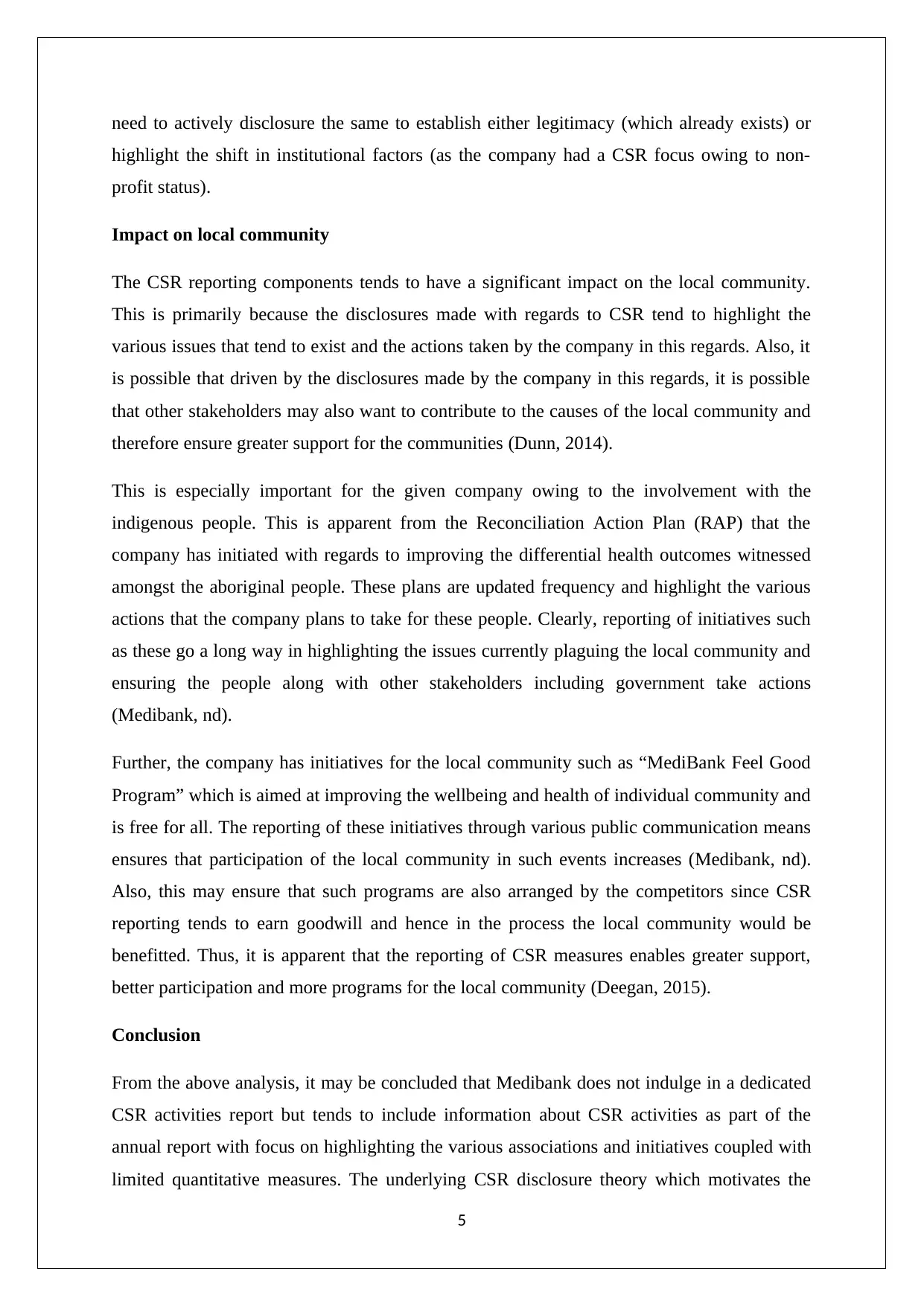
need to actively disclosure the same to establish either legitimacy (which already exists) or
highlight the shift in institutional factors (as the company had a CSR focus owing to non-
profit status).
Impact on local community
The CSR reporting components tends to have a significant impact on the local community.
This is primarily because the disclosures made with regards to CSR tend to highlight the
various issues that tend to exist and the actions taken by the company in this regards. Also, it
is possible that driven by the disclosures made by the company in this regards, it is possible
that other stakeholders may also want to contribute to the causes of the local community and
therefore ensure greater support for the communities (Dunn, 2014).
This is especially important for the given company owing to the involvement with the
indigenous people. This is apparent from the Reconciliation Action Plan (RAP) that the
company has initiated with regards to improving the differential health outcomes witnessed
amongst the aboriginal people. These plans are updated frequency and highlight the various
actions that the company plans to take for these people. Clearly, reporting of initiatives such
as these go a long way in highlighting the issues currently plaguing the local community and
ensuring the people along with other stakeholders including government take actions
(Medibank, nd).
Further, the company has initiatives for the local community such as “MediBank Feel Good
Program” which is aimed at improving the wellbeing and health of individual community and
is free for all. The reporting of these initiatives through various public communication means
ensures that participation of the local community in such events increases (Medibank, nd).
Also, this may ensure that such programs are also arranged by the competitors since CSR
reporting tends to earn goodwill and hence in the process the local community would be
benefitted. Thus, it is apparent that the reporting of CSR measures enables greater support,
better participation and more programs for the local community (Deegan, 2015).
Conclusion
From the above analysis, it may be concluded that Medibank does not indulge in a dedicated
CSR activities report but tends to include information about CSR activities as part of the
annual report with focus on highlighting the various associations and initiatives coupled with
limited quantitative measures. The underlying CSR disclosure theory which motivates the
5
highlight the shift in institutional factors (as the company had a CSR focus owing to non-
profit status).
Impact on local community
The CSR reporting components tends to have a significant impact on the local community.
This is primarily because the disclosures made with regards to CSR tend to highlight the
various issues that tend to exist and the actions taken by the company in this regards. Also, it
is possible that driven by the disclosures made by the company in this regards, it is possible
that other stakeholders may also want to contribute to the causes of the local community and
therefore ensure greater support for the communities (Dunn, 2014).
This is especially important for the given company owing to the involvement with the
indigenous people. This is apparent from the Reconciliation Action Plan (RAP) that the
company has initiated with regards to improving the differential health outcomes witnessed
amongst the aboriginal people. These plans are updated frequency and highlight the various
actions that the company plans to take for these people. Clearly, reporting of initiatives such
as these go a long way in highlighting the issues currently plaguing the local community and
ensuring the people along with other stakeholders including government take actions
(Medibank, nd).
Further, the company has initiatives for the local community such as “MediBank Feel Good
Program” which is aimed at improving the wellbeing and health of individual community and
is free for all. The reporting of these initiatives through various public communication means
ensures that participation of the local community in such events increases (Medibank, nd).
Also, this may ensure that such programs are also arranged by the competitors since CSR
reporting tends to earn goodwill and hence in the process the local community would be
benefitted. Thus, it is apparent that the reporting of CSR measures enables greater support,
better participation and more programs for the local community (Deegan, 2015).
Conclusion
From the above analysis, it may be concluded that Medibank does not indulge in a dedicated
CSR activities report but tends to include information about CSR activities as part of the
annual report with focus on highlighting the various associations and initiatives coupled with
limited quantitative measures. The underlying CSR disclosure theory which motivates the
5
⊘ This is a preview!⊘
Do you want full access?
Subscribe today to unlock all pages.

Trusted by 1+ million students worldwide
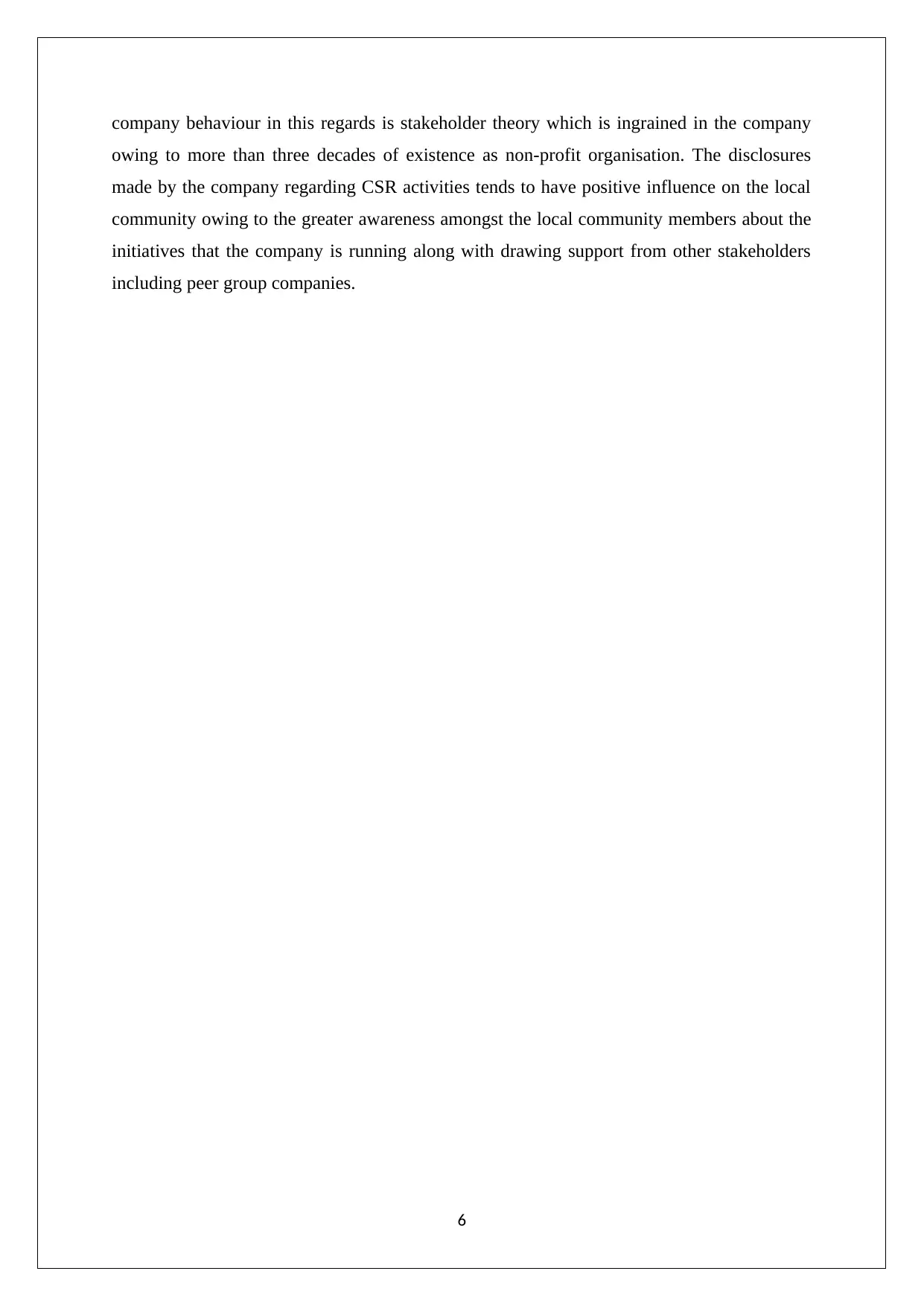
company behaviour in this regards is stakeholder theory which is ingrained in the company
owing to more than three decades of existence as non-profit organisation. The disclosures
made by the company regarding CSR activities tends to have positive influence on the local
community owing to the greater awareness amongst the local community members about the
initiatives that the company is running along with drawing support from other stakeholders
including peer group companies.
6
owing to more than three decades of existence as non-profit organisation. The disclosures
made by the company regarding CSR activities tends to have positive influence on the local
community owing to the greater awareness amongst the local community members about the
initiatives that the company is running along with drawing support from other stakeholders
including peer group companies.
6
Paraphrase This Document
Need a fresh take? Get an instant paraphrase of this document with our AI Paraphraser
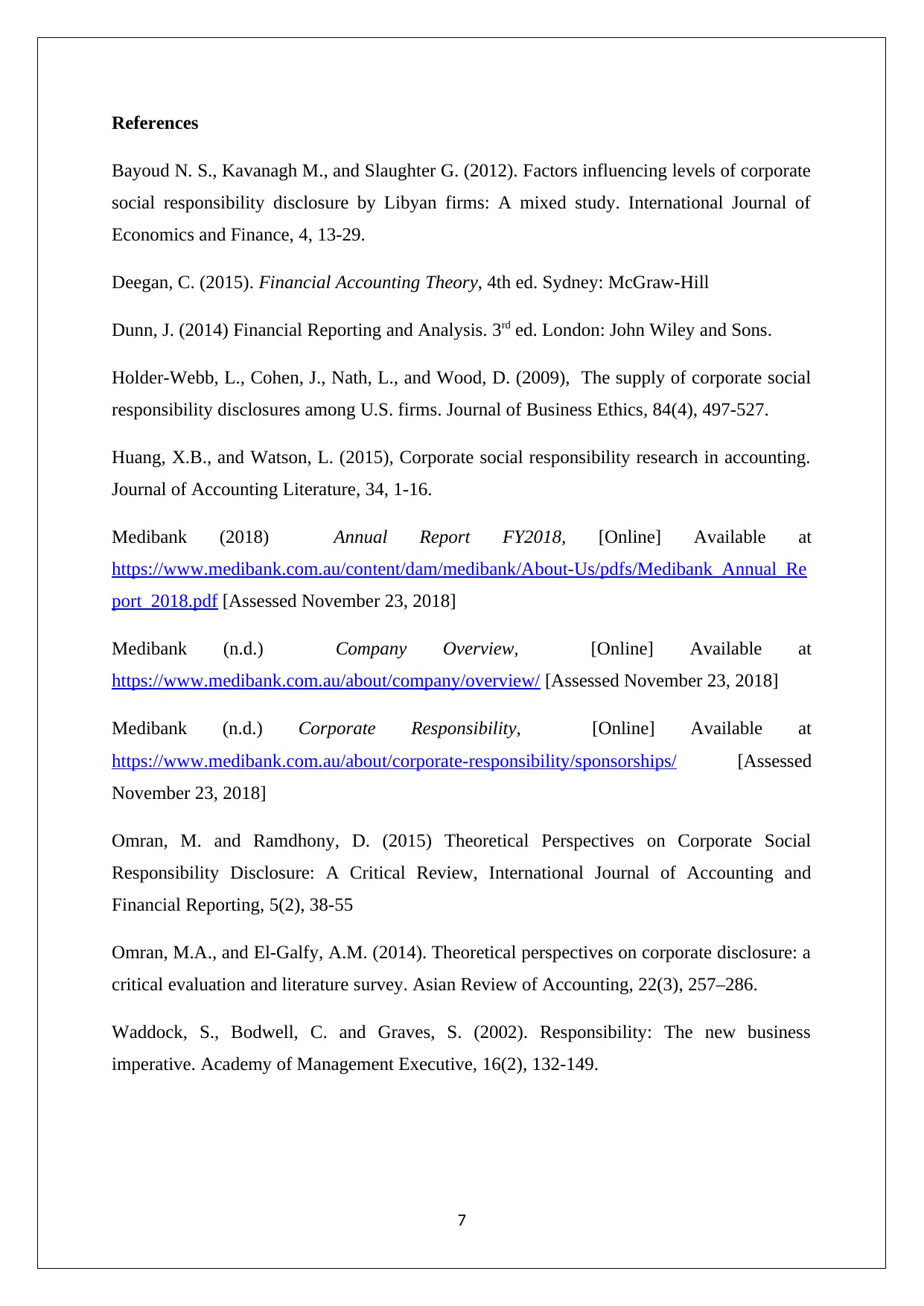
References
Bayoud N. S., Kavanagh M., and Slaughter G. (2012). Factors influencing levels of corporate
social responsibility disclosure by Libyan firms: A mixed study. International Journal of
Economics and Finance, 4, 13-29.
Deegan, C. (2015). Financial Accounting Theory, 4th ed. Sydney: McGraw-Hill
Dunn, J. (2014) Financial Reporting and Analysis. 3rd ed. London: John Wiley and Sons.
Holder-Webb, L., Cohen, J., Nath, L., and Wood, D. (2009), The supply of corporate social
responsibility disclosures among U.S. firms. Journal of Business Ethics, 84(4), 497-527.
Huang, X.B., and Watson, L. (2015), Corporate social responsibility research in accounting.
Journal of Accounting Literature, 34, 1-16.
Medibank (2018) Annual Report FY2018, [Online] Available at
https://www.medibank.com.au/content/dam/medibank/About-Us/pdfs/Medibank_Annual_Re
port_2018.pdf [Assessed November 23, 2018]
Medibank (n.d.) Company Overview, [Online] Available at
https://www.medibank.com.au/about/company/overview/ [Assessed November 23, 2018]
Medibank (n.d.) Corporate Responsibility, [Online] Available at
https://www.medibank.com.au/about/corporate-responsibility/sponsorships/ [Assessed
November 23, 2018]
Omran, M. and Ramdhony, D. (2015) Theoretical Perspectives on Corporate Social
Responsibility Disclosure: A Critical Review, International Journal of Accounting and
Financial Reporting, 5(2), 38-55
Omran, M.A., and El-Galfy, A.M. (2014). Theoretical perspectives on corporate disclosure: a
critical evaluation and literature survey. Asian Review of Accounting, 22(3), 257–286.
Waddock, S., Bodwell, C. and Graves, S. (2002). Responsibility: The new business
imperative. Academy of Management Executive, 16(2), 132-149.
7
Bayoud N. S., Kavanagh M., and Slaughter G. (2012). Factors influencing levels of corporate
social responsibility disclosure by Libyan firms: A mixed study. International Journal of
Economics and Finance, 4, 13-29.
Deegan, C. (2015). Financial Accounting Theory, 4th ed. Sydney: McGraw-Hill
Dunn, J. (2014) Financial Reporting and Analysis. 3rd ed. London: John Wiley and Sons.
Holder-Webb, L., Cohen, J., Nath, L., and Wood, D. (2009), The supply of corporate social
responsibility disclosures among U.S. firms. Journal of Business Ethics, 84(4), 497-527.
Huang, X.B., and Watson, L. (2015), Corporate social responsibility research in accounting.
Journal of Accounting Literature, 34, 1-16.
Medibank (2018) Annual Report FY2018, [Online] Available at
https://www.medibank.com.au/content/dam/medibank/About-Us/pdfs/Medibank_Annual_Re
port_2018.pdf [Assessed November 23, 2018]
Medibank (n.d.) Company Overview, [Online] Available at
https://www.medibank.com.au/about/company/overview/ [Assessed November 23, 2018]
Medibank (n.d.) Corporate Responsibility, [Online] Available at
https://www.medibank.com.au/about/corporate-responsibility/sponsorships/ [Assessed
November 23, 2018]
Omran, M. and Ramdhony, D. (2015) Theoretical Perspectives on Corporate Social
Responsibility Disclosure: A Critical Review, International Journal of Accounting and
Financial Reporting, 5(2), 38-55
Omran, M.A., and El-Galfy, A.M. (2014). Theoretical perspectives on corporate disclosure: a
critical evaluation and literature survey. Asian Review of Accounting, 22(3), 257–286.
Waddock, S., Bodwell, C. and Graves, S. (2002). Responsibility: The new business
imperative. Academy of Management Executive, 16(2), 132-149.
7
1 out of 8
Related Documents
Your All-in-One AI-Powered Toolkit for Academic Success.
+13062052269
info@desklib.com
Available 24*7 on WhatsApp / Email
![[object Object]](/_next/static/media/star-bottom.7253800d.svg)
Unlock your academic potential
Copyright © 2020–2026 A2Z Services. All Rights Reserved. Developed and managed by ZUCOL.





